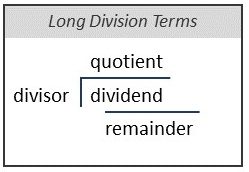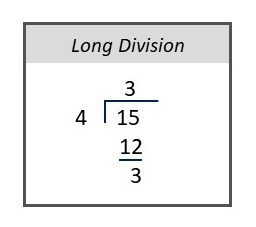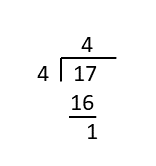2 Fractions
Learning Outcomes
By the end of this chapter, learners will be able to:
- define fraction, improper fraction and mixed fraction,
- simplify fractions,
- add and subtract fractions, and
- multiply and divide fractions.
Defining Fractions
A solid understanding of basic fractions is beneficial to health care workers, particularly when using Imperial measurements. Fractions are useful when describing information which relates to parts of a whole. A fraction is a way of documenting the amount of parts present out of the total number of parts of a thing. You will also see them used when writing ratios and proportion equations, using algebra and determining percentages.
Fractions always have a minimum of two parts, a numerator and a denominator:
[latex]\frac{\text{numerator}}{\text{denominator}}[/latex]
Sometimes, a whole number may precede a fraction. This is known as a mixed number. We see this often in baking recipes. For instance, you might see a recipe require [latex]1\frac{1}{4}[/latex] cups of sugar.
Consider a package of a dozen assorted doughnuts. If 3 of the 12 doughnuts were raisin bran, the fraction would read as follows:[latex]\frac{3}{12}[/latex]
The numerator is the portion present and the denominator are the number of parts in the whole (12 parts in a dozen).
Sample Exercise 2.1
How would you write a fraction if a pizza, with a total of 10 slices, had 5 slices with pineapple added on?
Answer:
[latex]\frac{5}{10}[/latex]
Fraction Types[1]
| Fraction | Terminology | Characteristics | Result of Division* |
| [latex]\Large\frac25[/latex] | Proper | The numerator is smaller than the denominator. | Answer is between [latex]0[/latex] and [latex]1[/latex] |
| [latex]\Large\frac52[/latex] | Improper | The numerator is larger than the denominator. | Answer is greater than [latex]1[/latex] |
| [latex]\Large3\frac25[/latex] | Mixed Number | A fraction that combines an integer with a proper fraction. When the division is performed, the proper fraction is added to the integer. | Answer is greater than the integer |
| [latex]\Large3\frac{\displaystyle¾}7[/latex] | Complex | A fraction that has fractions within fractions, combining elements of compound, proper, or improper fractions together. It is important to follow BEDMAS in resolving these fractions. | Answer varies depending on the fractions involved |
| [latex]\Large\frac12\;\normalsize\text{and}\;\Large\frac36[/latex] | Equivalent | Two or more fractions of any type that have the same numerical value upon completion of the division. Note that both of these examples work out to [latex]0.5[/latex]. | Answers are equal |
Proper Fractions: [latex]\quad \frac{7}{8} \quad \frac{2}{15} \quad \frac{1}{3}[/latex]
Improper Fractions: [latex]\quad \frac{9}{8} \quad \frac{6}{3} \quad \frac{12}{5}[/latex]
Mixed Fractions: [latex]\quad \frac{3}{4} \quad 4\frac{5}{8} \quad 1\frac{2}{5}[/latex]
Improper Fractions
Improper fractions are simply fractions which have a larger numerator than denominator. If you think about a proper fraction as representing a portion of a whole, an improper fraction would be representing a value greater than one. It represents more pieces than are available in one whole item.
For instance, we could use an improper fraction to describe the total number of pizza slices. The image below represents three personal pizzas, each cut into four pieces. There is one piece missing from the last pizza. The fraction to describe this situation is:
[latex]\displaystyle \frac{11}{4}[/latex]

Mixed Numbers
Mixed numbers also represent a value that is greater than one whole. Instead of the numerator being larger than the denominator, the fraction is written with the amount of whole portions before the fraction. If you look at the pizza picture above, there are 2 whole pizzas plus 3 pieces left out of the four pieces which make up a whole pizza. Written as a fraction it looks like this:
[latex]2\frac{3}{4}[/latex]
Things To Watch Out For
With complex fractions, it is critical to obey the rules of BEDMAS.
Note in the following example that an addition sign and two sets of brackets were hidden:
You should rewrite [latex]3\frac{\frac{3}{4}}{\displaystyle7}[/latex] as [latex]3+ \left[ \frac {\left( \frac{3}{4} \right) }{\displaystyle7} \right][/latex] before you attempt to solve with BEDMAS.
Converting Improper Fractions to Mixed Numbers
In order to write an improper fraction as a mixed number, we need to know how many whole units there are. You can determine how many whole units there are by dividing the numerator by the denominator. Long division works well for this process, as the remainder becomes the numerator and the quotient becomes the whole number to the left of the fraction. Let’s start by looking at the improper fraction [latex]\frac{11}{4}[/latex] from the example above.

Long division for improper fraction [latex]\frac{11}{4}[/latex]
[latex]\begin{array}{r}2\\4 \enclose{longdiv}{11} \\ \ \displaystyle \frac{8}{3} \end{array}[/latex]
Now to write as a mixed number:
The quotient (2) is the whole number written to the left of the fraction.
The remainder (3) is the numerator and the divisor (4) is the denominator.
[latex]2\frac{3}{4}[/latex]
Sample Exercise 2.2
Convert [latex]\frac{15}{4}[/latex] into a mixed number.
Answer:
[latex]3\frac{3}{4}[/latex]
Sample Exercise 2.3
Convert [latex]\frac{17}{4}[/latex] to a mixed number.
Answer:
Using long division:
[latex]4\frac{1}{4}[/latex]
Alternately:
First, divide the numerator by the denominator to find out how many whole units there are.
[latex]17\div 4 = 4.25[/latex]
The denominator stays the same.
The numerator is the portion of the whole: [latex]0.25 \text{or} \frac{1}{4}[/latex].
[latex]4\frac{1}{4}[/latex]
Converting Mixed numbers to Improper Fractions
When converting a mixed fraction to an improper fraction, the denominator always stays the same, as the number of parts in a whole item is not changing. To determine the numerator, you first multiply the whole number and denominator from the mixed fraction. This step determines how many pieces are in the number of whole items. Then add number of pieces represented by the numerator of the mixed fraction to this amount to calculate the total number of pieces. This number is now the new numerator of the improper fraction.
- [latex]2\frac{3}{4}[/latex]
- [latex]2\times4=8[/latex]
- [latex]8+3=11[/latex]
- [latex]\displaystyle \frac{11}{4}[/latex]
Sample Exercise 2.4
Convert [latex]3\frac{7}{8}[/latex] to an improper fraction.
Answer:
The denominator stays the same. 8.
To find the numerator, first multiply the whole number and denominator:
[latex]3 \times 8 = 24[/latex]
Add this number to the current numerator:
[latex]24 + 7 = 31[/latex]
Write the improper fraction:
[latex]\displaystyle \frac{31}{8}[/latex]
Simplifying Fractions
It is common practice to write fractions using the smallest numbers possible, as it is easier to conceptualize what the fraction represents when the numbers are small. This is also called reducing or simplifying fractions to its lowest terms. When we simplify a fraction, it does not change the size of the portion we are referring to because the relationship between the numerator and denominator does not change. For instance, try to picture [latex]\frac{2}{4}[/latex] of an orange. Now try to picture [latex]\frac{1}{2}[/latex] of an orange. They still refer to the same amount of the orange, even though the numbers of the fractions are different.
To simplify a fraction, you must divide the numerator and the denominator by the same number. If you are able to find the largest number you can divide both the numerator and denominator by, the fraction will be in simplified (or reduced) form. These numbers are also called the largest common factor.
As long as you divide by the same number, you do not change the relationship between the numerator and denominator. Fractions with small numbers, like [latex]\frac{2}{4}[/latex], can often be simplified with just one step, as it is easier to identify the largest common factor.
Fractions with larger numbers, like [latex]\frac{362}{900}[/latex] may take you a couple of steps, depending on your knowledge related to topics like multiplication tables and prime numbers Prime numbers have only two common factors, 1 and the number itself. If you spot a prime number in a fraction, you cannot simplify it any further (unless it can be divided by itself).
For example: [latex]\frac{13}{84}[/latex] = [latex]\frac{1}{8}[/latex]
To reduce large numbers you cannot identify the largest common factor of, try dividing by 2 if they are both even numbers, by 5 if they end in a 5, or by 10 if they end in zeros.
[latex]\displaystyle \frac{362}{900}[/latex]
In this case, it’s not clear what the largest common factor is. Since they are both even, they can be divided by 2.
[latex]\displaystyle\frac{362\div2}{900\div2}[/latex]
[latex]\displaystyle \frac{181}{450}[/latex]
181 is a prime number, so this fraction is now reduced.
Sample Exercise 2.5
Simplify the following fraction:
[latex]\frac{440}{1200}[/latex]
Answer:
[latex]\frac{440 \div 10}{1200 \div 10}=\frac{44}{120}[/latex]
[latex]\frac{44 \div 4}{120 \div 4}=\frac{11}{30}[/latex]
11 is a prime number, so now this fraction is reduced.
Adding and Subtracting Fractions
To add and subtract fractions, fractions must share the same denominator. When the denominators are the same, you can simply add or subtract the numerators as indicated in the math problem. Simplify the new fraction if possible.
Sample Addition of Fractions
[latex]\frac{1}{3}+\frac{3}{5}[/latex]
First, convert fractions as needed so they end up with the same denominator. In this case, we can make the common denominator 15.
[latex]\frac{1}{3}\times\frac{5}{5}=\frac{5}{15}[/latex]
[latex]\frac{3}{5}\times\frac{3}{3}=\frac{9}{15}[/latex]
Second, add the numerators.
[latex]\frac{5}{15}+\frac{9}{15}=\frac{14}{15}[/latex]
Third, simplify if possible.
[latex]\frac{14}{15}[/latex] is in the simplest form.
Sample Exercise 2.6
[latex]\frac{8}{12}-\frac{1}{6}[/latex]
Answer:
Find common denominator and convert fractions, subtract second numerator, simplify.
[latex]\frac{8}{12}-\left(\frac{1}{6} \times \frac{2}{2}\right)[/latex]
[latex]\frac{8}{12}-\frac{2}{12}=\frac{6}{12}[/latex]
[latex]\frac{6 \div 6}{12 \div 6}=\frac{1}{2}[/latex]
Multiplying Fractions
To multiply fractions, all you need to do is multiply the numerators together and then multiply the denominators together to determine the numerator and denominator of the new fraction. You will need to convert any mixed numbers to improper fractions before multiplying the numerators together. Simplify your answer as needed.
Sample Multiplication of Fractions
[latex]\frac{5}{7} \times \frac{2}{6}[/latex]
- First, check to see if there are mixed fractions which need to be converted to improper fractions. In this question, there is not.
- Multiply the numerators and then the denominators.
[latex]\frac{5 \times 2}{7 \times 6} = \frac{10}{42}[/latex]
- Simplify.
[latex]\frac{10 \div 2}{42 \div 2} = \frac{5}{21}[/latex]
Sample Exercise 2.7
[latex]\frac{3}{4}\times1\frac{1}{2}[/latex]
Answer:
Convert to an improper fraction:
[latex]\frac{3}{4} \times \frac{3}{2}[/latex]
Multiply numerators then denominators:
[latex]\frac{3\times3}{4 \times 2} = \frac{9}{8}[/latex]
Simplify:
[latex]1\frac{1}{8}[/latex]
Dividing Fractions
To divide fractions, start by converting any mixed numbers to improper fractions. To divide a fraction, you will actually multiply the first fraction by the reciprocal of the second. To create the reciprocal of a fraction, all you need to do is switch the places of the numerator and denominator.
Reciprocal Fractions
[latex]\displaystyle \frac{2}{3}= \frac{3}{2}[/latex]
Sample Division of Fractions
[latex]1\frac{7}{8}\div\frac{2}{3}[/latex]
- Convert any mixed fractions to improper fractions.
[latex]\frac{15}{8}\div\frac{2}{3}[/latex]
- Invert the second fraction to its reciprocal and change your symbol.
[latex]\frac{15}{8}\times\frac{3}{2}[/latex]
- Multiply across.
[latex]\frac{15}{8}\times\frac{3}{2} = \frac{45}{16}[/latex]
- Simplify.
[latex]\frac{45}{16} = 2\frac{13}{16}[/latex]
Sample Exercise 2.8
[latex]\frac{3}{12}\div\frac{2}{3}[/latex]
Answer:
Multiply the first fraction by the reciprocal of the second.
[latex]\frac{3}{12}\times\frac{3}{2} = \frac{9}{24}[/latex]
Divide the numerator and denominator by 3 to simplify.
[latex]\frac{3}{8}[/latex]
Key Takeaways
- Fractions are comprised of a numerator and denominator.
- Mixed numbers have a whole number to the left of the proper fraction.
- Improper fractions have a numerator larger than the denominator.
- To simplify fractions, divide the numerator and the denominator by the largest common factor.
- To add and subtract fractions, add or subtract the numerators of fractions with the same denominator.
- To multiply fractions, multiply the numerators and then multiply the denominators.
- To divide fractions, multiply the first fraction by the reciprocal of the second.
- Always simplify fractions when able.
Practice Set 2.1: Simplifying Fractions
Simplify the following fractions. Click the word Answers to check your work.
- [latex]\frac{6}{16}[/latex]
- [latex]\frac{3}{9}[/latex]
- [latex]\frac{10}{25}[/latex]
- [latex]\frac{32}{56}[/latex]
- [latex]\frac{22}{44}[/latex]
- [latex]\frac{14}{21}[/latex]
- [latex]\frac{13}{13}[/latex]
- [latex]\frac{30}{24}[/latex]
- [latex]\frac{66}{14}[/latex]
- [latex]\frac{70}{15}[/latex]
Answers:
- [latex]\frac{6\div2}{16\div2}=\frac{3}{8}[/latex]
- [latex]\frac{3\div3}{9\div3}=\frac{1}{3}[/latex]
- [latex]\frac{10\div5}{25\div5}=\frac{2}{5}[/latex]
- [latex]\frac{32\div8}{56\div8}=\frac{4}{7}[/latex]
- [latex]\frac{22\div22}{44\div22}=\frac{1}{2}[/latex]
- [latex]\frac{14\div7}{21\div7}=\frac{2}{3}[/latex]
- [latex]\frac{13\div13}{13\div13}=\frac{1}{1}=1[/latex]
- [latex]\frac{30\div6}{24\div6}=\frac{5}{4}=1\frac{1}{4}[/latex]
- [latex]\frac{66\div2}{14\div2}=\frac{33}{7}=4\frac{5}{7}[/latex]
- [latex]\frac{70\div5}{15\div5}=\frac{14}{3}=4\frac{2}{3}[/latex]
Practice Set 2.2: Adding and Subtracting Fractions
Add or subtract the following fractions. Click the word Answers to check your work.
- [latex]\frac{1}{3}+\frac{1}{3}[/latex]
- [latex]\frac{9}{10}-\frac{1}{5}[/latex]
- [latex]\frac{1}{4}+\frac{2}{3}[/latex]
- [latex]\frac{3}{4}-\frac{1}{7}[/latex]
- [latex]\frac{1}{2}+\frac{1}{4}[/latex]
- [latex]\frac{2}{3}-\frac{1}{9}[/latex]
- [latex]\frac{2}{5}+\frac{1}{6}[/latex]
- [latex]\frac{2}{3}+\frac{5}{6}[/latex]
- [latex]\frac{7}{8}-\frac{1}{2}[/latex]
- [latex]\frac{5}{6}-\frac{1}{10}[/latex]
Answers:
- [latex]\frac{2}{3}[/latex]
- [latex]\frac{9}{10}-\left(\frac{1}{5}\times\frac{2}{2}\right) = \frac{9}{10}-\frac{2}{10}=\frac{7}{10}[/latex]
- [latex]\left(\frac{1}{4}\times\frac{3}{3}\right)+\left(\frac{2}{3}\times\frac{4}{4}\right) = \frac{3}{12}+\frac{8}{12} = \frac{11}{12}[/latex]
- [latex]\left(\frac{3}{4}\times\frac{7}{7}\right)-\left(\frac{1}{7}\times\frac{4}{4}\right) = \frac{21}{28}-\frac{4}{28} = \frac{17}{28}[/latex]
- [latex]\left(\frac{1}{2}\times\frac{2}{2}\right)+\frac{1}{4} = \frac{2}{4}+\frac{1}{4} = \frac{3}{4}[/latex]
- [latex]\left(\frac{2}{3}\times\frac{3}{3}\right)-\frac{1}{9} = \frac{6}{9}-\frac{1}{9} = \frac{5}{9}[/latex]
- [latex]\left(\frac{2}{5}\times\frac{6}{6}\right)+\left(\frac{1}{6}\times\frac{5}{5}\right) = \frac{12}{30}+\frac{5}{30} = \frac{17}{30}[/latex]
- [latex]\left(\frac{2}{3}\times\frac{2}{2}\right)+\frac{5}{6} = \frac{4}{6}+\frac{5}{6} = \frac{9}{6} = 1\frac{3}{6} = 1\frac{1}{2}[/latex]
- [latex]\frac{7}{8}-\left(\frac{1}{2}\times\frac{4}{4}\right) = \frac{7}{8}-\frac{4}{8}=\frac{3}{8}[/latex]
- [latex]\left(\frac{5}{6}\times\frac{5}{5}\right)-\left(\frac{1}{10}\times\frac{3}{3}\right) = \frac{25}{30}-\frac{3}{30}=\frac{22}{30} = \frac{22\div2}{30\div2} = \frac{11}{15}[/latex]
Practice Set 2.3: Multiplying and Dividing Fractions
Multiply or divide the following. Be sure to simplify all answers and write them as a mixed numbers when possible. Click on the word Answers to check your work.
- [latex]\frac{7}{10}\times\frac{1}{5}[/latex]
- [latex]\frac{2}{4}\times\frac{1}{2}[/latex]
- [latex]\frac{3}{7}\times\frac{5}{12}[/latex]
- [latex]3\frac{2}{3}\times\frac{7}{8}[/latex]
- [latex]1\frac{3}{5}\times4\frac{5}{6}[/latex]
- [latex]\frac{4}{9}\div\frac{1}{2}[/latex]
- [latex]\frac{2}{3}\div\frac{6}{10}[/latex]
- [latex]\frac{3}{5}\div\frac{4}{7}[/latex]
- [latex]\frac{6}{13}\div\frac{4}{5}[/latex]
- [latex]\frac{1}{4}\div\frac{3}{9}[/latex]
Answers:
- [latex]\frac{7}{50}[/latex]
- [latex]\frac{2}{8} = \frac{1}{4}[/latex]
- [latex]\frac{3}{7}\times\frac{5}{12} = \frac{15}{84}= \frac{5}{28}[/latex]
- [latex]\frac{11}{3}\times\frac{7}{8} = \frac{77}{24} = 3\frac{5}{24}[/latex]
- [latex]\frac{8}{5}\times\frac{29}{6}= \frac{232}{30} = 7\frac{22}{30} = 7\frac{11}{15}[/latex]
- [latex]\frac{4}{9}\times\frac{2}{1} = \frac{8}{9}[/latex]
- [latex]\frac{2}{3}\times\frac{10}{6} = \frac{20}{18} = 1\frac{2}{18} = 1\frac{1}{9}[/latex]
- [latex]\frac{3}{5}\times\frac{7}{4} = \frac{21}{20} = 1\frac{1}{20}[/latex]
- [latex]\frac{6}{13}\times\frac{5}{4} = \frac{30}{52}= \frac{15}{26}[/latex]
- [latex]\frac{1}{4}\times\frac{9}{3} = \frac{9}{12}= \frac{3}{4}[/latex]
Case Studies
Scenario A: Nutrition Calculation for Diabetic Patients
At a long-term care facility in Cape Breton, you assist in meal planning for diabetic patients. The total daily carbohydrate intake for a patient must be 200 grams. Breakfast should provide ¼ of the total intake, lunch should provide [latex]\frac{1}{3}]/latex] , and dinner should provide the remaining amount. Task A: Calculate how many grams of carbohydrates should be included in each meal.
Answer
Answer A) The patient should receive 50 grams of carbs at breakfast, approximately 66.67 grams at lunch, and 83.33 grams at dinner. Solution A:
- Total carbohydrates = 200 grams
- [latex]/text{Breakfast} = \frac{1}{4} \text{of} 200 \text{grams} = 200 \div 4 = 50 \text{grams}[/latex]
- [latex]Lunch = \frac{1}{3} \text{of} 200 \text{grams} = 200 \div 3 = 66.67 grams[/latex]
- [latex]\text{Dinner} = \text{Remaining carbs} = 200 - \left( 50 + 66.67 \right) = 83.33 \text{grams}[/latex]
Scenario B: IV Fluid Infusion Rate
A patient in Yarmouth Regional Hospital requires IV fluids over a period of 8 hours. The total prescribed fluid amount is 1,200 mL. However, due to the patient's condition, you are instructed to administer only half of the amount in the first 4 hours and the rest in the remaining 4 hours.
Task B: Determine the amount of fluid to administer in each of the two 4-hour periods and what fraction of the total amount will be given in the first half.
Answer
Answer B: 600 mL will be administered in the first 4 hours and another 600 mL in the next 4 hours.
Solution B:
- Total fluid = 1,200 mL
- Half in the first [latex]{latex]4\text{hours } = 1200 \div 2 = 600 \text{mL}[/latex]
The fraction of the total amount given in the first half is [latex]\frac{600}{1200} = \frac{1}{2}[/latex] .
Chapter Credit
Adapted from Chapter 3 Fractions in A Guide for Numeracy in Nursing by Julia Langham, CC BY 4.0.
Case Studies are new content.
- Table from 2.2: Fractions, Decimals, & Rounding from Business Math: A Step-by-Step Handbook (2021B) by J. Olivier and Lyryx Learning Inc. through a CC BY-NC-SA License ↵
A ratio is a numerical expression which shows the connection between two or more related numbers.
The number on top of a fraction.
The number on the bottom of a fraction.
A fraction with a numerator larger than the denominator.
A fraction representing more than one whole, using a whole number to the left of the numerator and denominator.
The largest factor shared by a group of numbers.
Prime numbers only have two factors, the number one and the number itself.
The reciprocal of a fraction is a fraction made by switching the places of the numerator and denominator.

